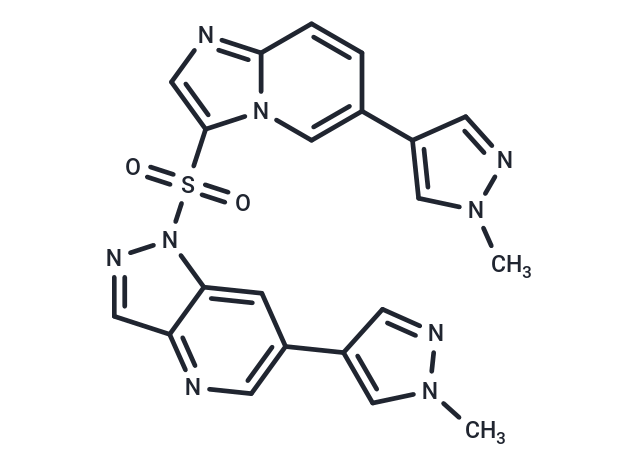Shopping Cart
- Remove All
 Your shopping cart is currently empty
Your shopping cart is currently empty

Glumetinib (SCC244) is a novel potent and selective inhibitor of c-Met kinase (IC50: 0.42 nM).

| Pack Size | Price | Availability | Quantity |
|---|---|---|---|
| 1 mg | $50 | In Stock | |
| 5 mg | $113 | In Stock | |
| 10 mg | $173 | In Stock | |
| 25 mg | $292 | In Stock | |
| 50 mg | $437 | In Stock | |
| 100 mg | $646 | In Stock |
| Description | Glumetinib (SCC244) is a novel potent and selective inhibitor of c-Met kinase (IC50: 0.42 nM). |
| Targets&IC50 | c-Met:0.42 nM (cell free) |
| In vitro | Glumetinib exhibited high potency (IC50: 0.42 nM) against purified c-Met kinase activity using ELISA kinase assay. Glumetinib has greater than 2,400-fold selectivity for c-Met over those 312 kinases evaluated, including the c-Met family member RON and highly homologous kinases Axl, Mer, and TyrO3. Glumetinib strongly suppressed HGF-induced NCI-H441 cell motility and invasion in a dose-dependent manner and was sufficient to block the movement of most cells at a dose of 10 nmol/L. |
| In vivo | In the MKN-45 model, Glumetinib significantly inhibited tumor growth with inhibitory rates of 99.3%, 88.6%, and 63.6% at doses of 10, 5, and 2.5 mg/kg, respectively. In addition, tumor stasis was observed following a 21-day treatment with 5 and 10 mg/kg Glumetinib. Similar results were obtained in the SNU-5 model treated with Glumetinib, and tumor regression was observed in the high dose group. In the EBC-1 study, all mice receiving Glumetinib exhibited a greater than 66.0% decrease in tumor mass, and in both the 10 and 5 mg/kg treatment groups, 1 of 6 mice exhibited no evidence of a tumor. Moreover, in all the tested models, the efficacy of Glumetinib at 10 mg/kg is comparable with that of INCB28060 at 15 mg/kg and crizotinib at 50 mg/kg. |
| Kinase Assay | Met, Ron, Axl, TyrO3, and Mer kinases activity were assessed using both ELISA and radiometric protein kinase assays. The kinase selectivity profile of SCC244 (1 μmol/L) was screened against a panel of other 308 recombinant kinases using radiometric protein kinase assays was also performed according to the manufacturer's specifications. |
| Cell Research | Cells were seeded in 96-well plates at a low density in growth media. The next day, appropriate controls or designated concentrations of compounds were added to each well, and the cells were incubated for 72 hours. HUVECs (passage 3) were seeded in 96-well plates in growth media overnight and transferred to serum-free media for 24 hours. The following day, appropriate controls or designated concentrations of compounds were added to each well, and HGF was added to designated wells at 100 ng/mL. The cells were incubated for 48 hours. Finally, cell proliferation was determined using a sulforhodamine B assay, a thiazolyl blue tetrazolium bromide assay or a cell counting kit (CCK-8) assay. |
| Animal Research | To assess the pharmacodynamics of SCC244 in tumors, mice bearing established xenograft tumors were treated with a single dose of the compound at 10 or 2.5 mg/kg, and tumors were harvested at several time points. At a designated time following administration, mice were humanely euthanized, and their tumors were resected. The tumors were snap-frozen in liquid nitrogen and then homogenized in 500 μL of protein extraction solution (radioimmunoprecipitation assay, RIPA). The tumor extracts were then subjected to Western blot analysis. The individual bands of phospho-c-Met, phospho-AKT, and phospho-ERK were scanned and quantified using Gel Pro Analyzer software. The relative tyrosine phosphorylation of each sample at the indicated time points was then calculated, with the average value of vehicle-treated sample used as 100%. |
| Alias | SCC244 |
| Molecular Weight | 459.48 |
| Formula | C21H17N9O2S |
| Cas No. | 1642581-63-2 |
| Smiles | Cn1cc(cn1)-c1cnc2cnn(c2c1)S(=O)(=O)c1cnc2ccc(cn12)-c1cnn(C)c1 |
| Relative Density. | 1.61 g/cm3 (Predicted) |
| Storage | Powder: -20°C for 3 years | In solvent: -80°C for 1 year | Shipping with blue ice. | ||||||||||||||||||||
| Solubility Information | DMSO: 4.59 mg/mL (10 mM), Sonication is recommended. | ||||||||||||||||||||
Solution Preparation Table | |||||||||||||||||||||
DMSO
| |||||||||||||||||||||

Copyright © 2015-2025 TargetMol Chemicals Inc. All Rights Reserved.